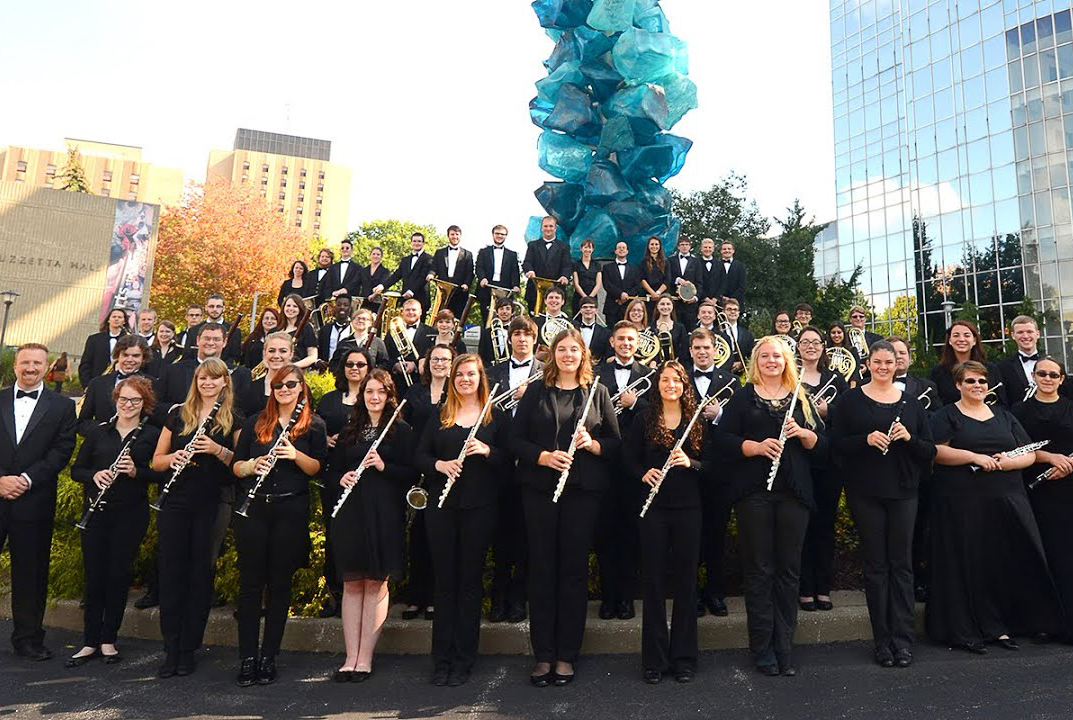by Nicholas Stevens

Part of the Kulas Concert Series, the School’s annual “Collage” concert brings students, faculty, and distinguished guests together in a pause-free continuum. This year, the concert took the form of a video, streamed on Wednesday, October 28 and unavailable thereafter.
The first ensemble, UA Samba, pulled viewers into a vortex of irresistible rhythm right away. Beautifully coordinated, the percussionists recorded Michael Spiro’s Samba Batucada together — outside, masked, and spaced apart. (Names of all performers are available on UA’s webpage for the event.) Randall Standridge’s Fiat Lux followed on its heels, as performed by the Wind Symphony via multi-tracked video. Resting atop a strong low-register foundation, the band conveyed uplift at every turn.
Resanovic’s The Ox and the Lark, as rendered by faculty saxophonist Todd Gaffke and clarinetist Stanislav Golovin, exuded seriousness reminiscent of Stravinsky, while BassoonaRoo’s “This is Halloween” exuded insouciant playfulness somehow also reminiscent of Stravinsky. The Freshman Percussion Ensemble showed both accuracy and spirit, as did piano soloist Mikayla Kreider in a reading of Prokofiev marred only by dubious video quality.
Distracting video effects did not detract from a jazz combo feature for clean-toned guitarist Chandler Carpenter, nor from Robert Brownlow’s Critter Bagatelles as played by faculty bassoonists Cynthia Cioffari and Alexander Morris, who performed with such verve that the visual element mattered little. The lovely, near-soubrette voice of soprano Ashlee Foreman brought life to “Saper vorreste” from Verdi’s Un Ballo in Maschera, delivered with powerful high notes and a strong sense of pitch. Her voice is young and her Italian in progress, but Foreman is a singer to watch. A faculty trio rounded out the first half of the program, with bass-baritone Frank Ward, Jr. joining Golovin and pianist-composer James Wilding for the latter’s own folk-influenced I am Going Home to Thee.
The recording of the UA Drum Line caught not just the percussionists’ sound, but also its echo against nearby buildings, making Loferski’s Onward a bit disorienting. Arne Running’s Quodlibet for wind quintet was a whirlwind for different reasons: blending references to iconic classical compositions with circus music, it put each player in the spotlight. Hornist Maria Carmona Ruiz stood out early and often.
The final act of the concert delivered several highlights, starting with the Jazz Ensemble’s take on New Birth, a group-devised work delivering moving words on systemic and quotidian injustices. Soprano Alexis Johnson sang Wolf’s Auch kleine Dinge impeccably, strong in emotion, tone, pitch, phrasing, and diction alike. Stan Vincent’s pop song O-o-h Child swayed in an arrangement for the Steel Band, a contrast with the seriousness of purpose that pervaded Kristofor Downs’s solo turn on Brindle’s Sonata No. 4 for guitar.
Claudia Namenyi brought suitable virtuosic flair to Bortkiewicz’s Esquisses de Crimée, and Paragon Brass likewise played with a firm sense of style in the swinging That’s a Plenty by Lew Pollack. A strong left hand and sense of direction gave faculty pianist Philip Thomson’s reading of Godowsky’s Triakontameron No. 1 powerful allure. A visit from the Flute Choir and a return by the Wind Symphony preceded the evening’s most simple and moving performance: the University’s alma mater, sung by the Concert Choir. May we all have the chance to visit UA’s architectural treasure, E.J. Thomas Hall, to hear these performers in person someday soon.
Published on ClevelandClassical.com November 3, 2020
Click here for a printable copy of this article



